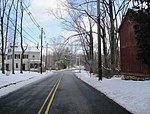Colross (also historically known as Belle Air and Grasshopper Hall) is a Georgian style mansion built around 1800 as the center of a large plantation in what is now the Old Town neighborhood of Alexandria, Virginia, and moved circa 1930 to Princeton, New Jersey, where it is currently the administration building of Princeton Day School.
The Colross property originally occupied the entire 1100 block of Oronoco Street; Alexandria merchant John Potts developed it as a plantation and began building the mansion in 1799–1800. In 1803, Jonathan Swift—also an Alexandria merchant and a city councilman—purchased the property and during his ownership continued constructing the mansion. After Swift died in 1824, Colross was purchased by Thomson Francis Mason (1785–1838), son of Thomson Mason (1759–1820) and grandson of Founding Father George Mason (1725–1792) of Gunston Hall. Mason served as a judge of the Criminal Court of the District of Columbia and as mayor of Alexandria. Mason, who made Colross his chief homestead, modified and enlarged the mansion. After successive ownerships, the area around Colross became heavily industrialized. The mansion was bought by John Munn in 1929; between that year and 1932, it was transported brick-by-brick to Princeton, where in 1958 it was sold to Princeton Day School, which uses it as a school administration building housing its admission and advancement offices.
The Colross mansion is a two-story, brick, Georgian-style structure that features an architectural plan similar to that of Mount Vernon and Woodlawn, and it was originally flanked by two wings. The front entrance is covered by a spacious Neoclassical portico that is supported by wooden Doric columns. The roof is topped by a balustraded deck and is further embellished by three dormer windows.
In 2005, after the original Colross site was purchased by a real estate development company, the city of Alexandria requested an excavation by archaeologists, who uncovered an underground domed brick cistern, evidence of slave outbuildings, the foundations of the estate's peripheral walls, and several ancillary structures.
Colross served as the venue for several significant Mason family events, including the wedding ceremonies of Thomson Francis Mason's daughters Sarah Elizabeth Mason (1819–1907) and Virginia Mason (1830–1919). According to local tradition, two children in the Mason family died on the property and were interred in the estate's burial vault. Successive owners of the Colross estate claimed it was haunted by the deceased Mason children.







